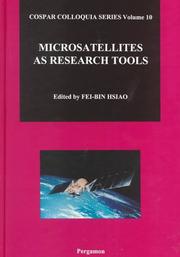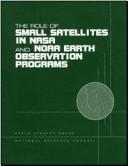| Listing 1 - 10 of 12 | << page >> |
Sort by
|

ISBN: 1281050008 9786611050009 0080536522 0444501967 9780080536521 9780444501967 Year: 1999 Publisher: [New York] : Pergamon,
Abstract | Keywords | Export | Availability | Bookmark
 Loading...
Loading...Choose an application
- Reference Manager
- EndNote
- RefWorks (Direct export to RefWorks)
In order to reflect the increasing importance and interest of the microsatellites in high technology and scientific applications in space, the Colloquium on Microsatellites as Research Tools was organized to promote its usage and technology development and to foster the international cooperation, especially in the area of the Asia pacific region. Attended by 150 participants from 18 countries the colloquium was organized into five major themes: regional development, lessons learned, innovations, scientific applications, and education. A special session was organized as well by the organizing
Microspacecraft --- Scientific satellites --- Lightsats --- Micro satellites --- Microsats --- Small satellites --- Small spacecraft --- Spacecraft, Micro --- Ultra compact spacecraft --- Ultralightweight spacecraft --- Space vehicles

ISBN: 0585361045 9780585361048 9780833025289 0833025287 Year: 1998 Publisher: Santa Monica, CA RAND, Critical Technologies Institute
Abstract | Keywords | Export | Availability | Bookmark
 Loading...
Loading...Choose an application
- Reference Manager
- EndNote
- RefWorks (Direct export to RefWorks)
Microspacecraft. --- Microspacecraft --- Mechanical Engineering --- Engineering & Applied Sciences --- Aeronautics Engineering & Astronautics --- Lightsats --- Micro satellites --- Microsats --- Small satellites --- Small spacecraft --- Spacecraft, Micro --- Ultra compact spacecraft --- Ultralightweight spacecraft --- Space vehicles
Book
ISBN: 0128126736 9780128126738 0128126728 9780128126721 9780128126721 Year: 2018 Publisher: Oxford, [England] : Butterworth-Heinemann,
Abstract | Keywords | Export | Availability | Bookmark
 Loading...
Loading...Choose an application
- Reference Manager
- EndNote
- RefWorks (Direct export to RefWorks)
Microspacecraft. --- Nanosatellites. --- Nano-satellites --- Artificial satellites --- Lightsats --- Micro satellites --- Microsats --- Small satellites --- Small spacecraft --- Spacecraft, Micro --- Ultra compact spacecraft --- Ultralightweight spacecraft --- Space vehicles --- Nanosatèl·lits --- Satèl·lits petits.
Book
ISBN: 9780128190388 0128190388 9780128190371 012819037X Year: 2022 Publisher: Amsterdam, Netherlands : Elsevier Inc.,
Abstract | Keywords | Export | Availability | Bookmark
 Loading...
Loading...Choose an application
- Reference Manager
- EndNote
- RefWorks (Direct export to RefWorks)
Space Micropropulsion for Nanosatellites: Progress, Challenges and Future features the latest developments and progress, the challenges faced by different researchers, and insights on future micropropulsion systems. Nanosatellites, in particular cubesats, are an effective test bed for new technologies in outer space. However, most of the nanosatellites have no propulsion system, which subsequently limits their maneuverability in space.
Microspacecraft. --- Nanosatellites --- Propulsion systems. --- Propulsion systems --- Lightsats --- Micro satellites --- Microsats --- Small satellites --- Small spacecraft --- Spacecraft, Micro --- Ultra compact spacecraft --- Ultralightweight spacecraft --- Space vehicles
Book
ISBN: 0128245425 9780128245422 0128245417 9780128245415 Year: 2023 Publisher: Amsterdam, Netherlands : Elsevier Inc.,
Abstract | Keywords | Export | Availability | Bookmark
 Loading...
Loading...Choose an application
- Reference Manager
- EndNote
- RefWorks (Direct export to RefWorks)
Next Generation of CubeSats and SmallSats: Enabling Technologies, Missions, and Markets provides a comprehensive understanding of the small and medium sized satellite approach and its potentialities and limitations. The book analyzes promising applications (e.g., constellations and distributed systems, small science platforms that overachieve relative to their development time and cost) as paradigm-shifting solutions for space exploitation, with an analysis of market statistics and trends and a prediction of where the technologies, and consequently, the field is heading in the next decade. The book also provides a thorough analysis of CubeSat potentialities and applications, and addresses unique technical approaches and systems strategies. Throughout key sections (introduction and background, technology details, systems, applications, and future prospects), the book provides basic design tools scaled to the small satellite problem, assesses the technological state-of-the-art, and describes the most recent advancements with a look to the near future. This new book is for aerospace engineering professionals, advanced students, and designers seeking a broad view of the CubeSat world with a brief historical background, strategies, applications, mission scenarios, new challenges and upcoming advances.
Microspacecraft. --- Lightsats --- Micro satellites --- Microsats --- Small satellites --- Small spacecraft --- Spacecraft, Micro --- Ultra compact spacecraft --- Ultralightweight spacecraft --- Space vehicles --- Vehicles espacials --- Naus espacials --- Astronàutica --- Coets (Aeronàutica) --- Vehicles
Book
ISBN: 012817885X 9780128178850 0128178841 9780128178843 Year: 2021 Publisher: London Academic Press
Abstract | Keywords | Export | Availability | Bookmark
 Loading...
Loading...Choose an application
- Reference Manager
- EndNote
- RefWorks (Direct export to RefWorks)
Artificial satellites --- Microspacecraft --- Design and construction. --- Lightsats --- Micro satellites --- Microsats --- Small satellites --- Small spacecraft --- Spacecraft, Micro --- Ultra compact spacecraft --- Ultralightweight spacecraft --- Space vehicles --- Earth satellites --- Orbiting vehicles --- Satellite vehicles --- Satellites, Artificial --- Anti-satellite weapons
Book
ISBN: 0128218665 0128218657 9780128218655 9780128218662 Year: 2021 Publisher: London : Academic Press, an imprint of Elsevier,
Abstract | Keywords | Export | Availability | Bookmark
 Loading...
Loading...Choose an application
- Reference Manager
- EndNote
- RefWorks (Direct export to RefWorks)
Microspacecraft. --- Signal processing --- Digital techniques. --- Digital signal processing --- Digital communications --- Digital electronics --- Lightsats --- Micro satellites --- Microsats --- Small satellites --- Small spacecraft --- Spacecraft, Micro --- Ultra compact spacecraft --- Ultralightweight spacecraft --- Space vehicles

ISBN: 0309069823 9786610185528 128018552X 030959409X 0585254893 9780585254890 9780309069823 9780309594097 0309183707 9780309183703 6610185522 Year: 2000 Publisher: Washington, D.C. National Academy Press
Abstract | Keywords | Export | Availability | Bookmark
 Loading...
Loading...Choose an application
- Reference Manager
- EndNote
- RefWorks (Direct export to RefWorks)
Microspacecraft - United States. --- Microspacecraft --- Artificial satellites in earth sciences --- Aeronautics Engineering & Astronautics --- Mechanical Engineering --- Engineering & Applied Sciences --- United States. --- Lightsats --- Micro satellites --- Microsats --- Small satellites --- Small spacecraft --- Spacecraft, Micro --- Ultra compact spacecraft --- Ultralightweight spacecraft --- N.O.A.A. --- National Oceanic and Atmospheric Administration (U.S.) --- NOAA --- N.A.S.A. --- NASA --- NASA Headquarters --- National Aeronautics and Space Administration (U.S.) --- Nat︠s︡ionalʹnoe upravlenie po aėronavtike i issledovanii︠u︡ kosmicheskogo prostranstva SShA --- Earth sciences --- Space vehicles
Book
ISBN: 1281397466 9786611397463 140206943X 1402069421 9048177723 Year: 2008 Publisher: Dordrecht : Springer,
Abstract | Keywords | Export | Availability | Bookmark
 Loading...
Loading...Choose an application
- Reference Manager
- EndNote
- RefWorks (Direct export to RefWorks)
This book deals with different aspects of small satellites for Earth observation - programmatics - current and planned Earth observation missions - spacebased instruments - satellite constellations - satellite subsystems - spacecraft bus systems - lessons learned - special aspects (e.g. thermal control, integration and test, launch services, ground station). The material provided is collected from the 6th IAA Symposium on Small Satellites for Earth Observation, initiated by the International Academy of Astronautics (IAA), and hosted by DLR, the German Aerospace Center. The participation of scientists, engineers, and managers from 24 countries reflected the high interest in the use of small satellites for dedicated missions applied to Earth observation. As in the previous symposia, the contributions showed that dedicated Earth observation missions cover a wide range of very different tasks. These missions provide increased opportunities for access to space and can be conducted relatively quickly and inexpensively. The spacecraft bus, the instruments, and the ground systems can be based either on optimized off-the-shelf systems with little or no requirements for new technology, or on new high-technology designs. Audience: This book will be of interest to practitioners and professionals in the remote sensing field.
Artificial satellites --- Microspacecraft --- Artificial satellites in remote sensing --- Lightsats --- Micro satellites --- Microsats --- Small satellites --- Small spacecraft --- Spacecraft, Micro --- Ultra compact spacecraft --- Ultralightweight spacecraft --- Space vehicles --- Astrophysics. --- Astronautics. --- Remote Sensing/Photogrammetry. --- Space Sciences (including Extraterrestrial Physics, Space Exploration and Astronautics). --- Aerospace Technology and Astronautics. --- Astronomical physics --- Astronomy --- Cosmic physics --- Physics --- Space sciences --- Aeronautics --- Astrodynamics --- Space flight --- Remote sensing. --- Space sciences. --- Aerospace engineering. --- Science and space --- Space research --- Cosmology --- Science --- Aeronautical engineering --- Astronautics --- Engineering --- Remote-sensing imagery --- Remote sensing systems --- Remote terrain sensing --- Sensing, Remote --- Terrain sensing, Remote --- Aerial photogrammetry --- Aerospace telemetry --- Detectors --- Space optics
Book
ISBN: 3319235028 3319235036 Year: 2016 Publisher: Cham : Springer International Publishing : Imprint: Springer,
Abstract | Keywords | Export | Availability | Bookmark
 Loading...
Loading...Choose an application
- Reference Manager
- EndNote
- RefWorks (Direct export to RefWorks)
This book represents the Flight Operations Manual for a reusable microsatellite platform – the “Future Low-cost Platform” (FLP), developed at the University of Stuttgart, Germany. It provides a basic insight on the onboard software functions, the core data handling system and on the power, communications, attitude control and thermal subsystem of the platform. Onboard failure detection, isolation and recovery functions are treated in detail. The platform is suited for satellites in the 50-150 kg class and is baseline of the microsatellite “Flying Laptop” from the University. The book covers the essential information for ground operators to controls an FLP-based satellite applying international command and control standards (CCSDS and ECSS PUS). Furthermore it provides an overview on the Flight Control Center in Stuttgart and on the link to the German Space Agency DLR Ground Station which is used for early mission phases. Flight procedure and mission planning chapters complement the book. .
Aeronautics Engineering & Astronautics --- Mechanical Engineering --- Engineering & Applied Sciences --- Artificial satellites --- Microspacecraft. --- Control systems. --- Lightsats --- Micro satellites --- Microsats --- Small satellites --- Small spacecraft --- Spacecraft, Micro --- Ultra compact spacecraft --- Ultralightweight spacecraft --- Space vehicles --- Flight control --- Astronautics. --- Software engineering. --- Electronics. --- Aerospace Technology and Astronautics. --- Special Purpose and Application-Based Systems. --- Electronics and Microelectronics, Instrumentation. --- Electrical engineering --- Physical sciences --- Computer software engineering --- Engineering --- Space sciences --- Aeronautics --- Astrodynamics --- Space flight --- Aerospace engineering. --- Special purpose computers. --- Microelectronics. --- Microminiature electronic equipment --- Microminiaturization (Electronics) --- Electronics --- Microtechnology --- Semiconductors --- Miniature electronic equipment --- Special purpose computers --- Computers --- Aeronautical engineering --- Astronautics
| Listing 1 - 10 of 12 | << page >> |
Sort by
|

 Search
Search Feedback
Feedback About UniCat
About UniCat  Help
Help News
News